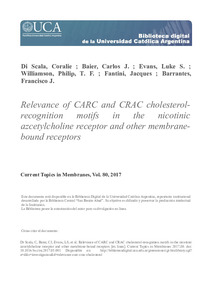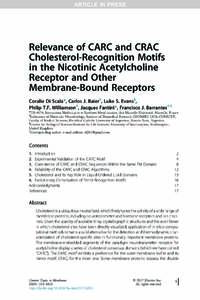Por favor, use este identificador para citar o enlazar este ítem:
https://repositorio.uca.edu.ar/handle/123456789/1460| Título: | Relevance of CARC and CRAC cholesterol-recognition motifs in the nicotinic azcetylcholine receptor and other membrane-bound receptors | Autor: | Di Scala, Coralie Baier, Carlos J. Evans, Luke S. Williamson, Philip, T. F. Fantini, Jacques Barrantes, Francisco José |
Palabras clave: | COLESTEROL; PROTEINAS; NEUROTRANSMISORES | Fecha de publicación: | 2017 | Editorial: | Elsevier | Cita: | Di Scala, C., et al. Relevance of CARC and CRAC cholesterol-recognition motifs in the nicotinic azcetylcholine receptor and other membrane-bound receptors [en línea]. Postprint del artículo publicado en Current Topics in Membranes. 2017, 80. doi:10.1016/bs.ctm.2017.05.001. Disponible en: https://repositorio.uca.edu.ar/handle/123456789/1460 | Resumen: | Abstract: Cholesterol is a ubiquitous neutral lipid, which finely tunes the activity of a wide range of membrane proteins, including neurotransmitter and hormone receptors and ion channels. Given the scarcity of available X-ray crystallographic structures and the even fewer in which cholesterol sites have been directly visualized, application of in silico computational methods remains a valid alternative for the detection and thermodynamic characterization of cholesterol-specific sites in functionally important membrane proteins. The membrane-embedded segments of the paradigm neurotransmitter receptor for acetylcholine display a series of cholesterol consensus domains (which we have coined “CARC”). The CARC motif exhibits a preference for the outer membrane leaflet and its mirror motif, CRAC, for the inner one. Some membrane proteins possess the double CARC–CRAC sequences within the same transmembrane domain. In addition to in silico molecular modeling, the affinity, concentration dependence, and specificity of the cholesterol-recognition motif–protein interaction have recently found experimental validation in other biophysical approaches like monolayer techniques and nuclear magnetic resonance spectroscopy. From the combined studies, it becomes apparent that the CARC motif is now more firmly established as a high-affinity cholesterol-binding domain for membrane-bound receptors and remarkably conserved along phylogenetic evolution. | URI: | https://repositorio.uca.edu.ar/handle/123456789/1460 | ISSN: | 1063-5823 | Disciplina: | MEDICINA | DOI: | 10.1016/bs.ctm.2017.05.001 | Derechos: | Acceso Abierto. 1 año de embargo | Fuente: | Postprint del artículo publicado en Current Topics in Membranes 2017, 80 1063-5823 |
| Aparece en las colecciones: | Artículos |
Ficheros en este ítem:
| Fichero | Descripción | Tamaño | Formato | |
|---|---|---|---|---|
| relevance-carc-crac-cholesterol.pdf | 719,7 kB | Adobe PDF |  Visualizar/Abrir | |
| relevance-carc-crac-cholesterol-2.jpg | 472,88 kB | JPEG |  Visualizar/Abrir |
Visualizaciones de página(s)
142
comprobado en 30-abr-2024
Descarga(s)
774
comprobado en 30-abr-2024
Google ScholarTM
Ver en Google Scholar
Altmetric
Altmetric
Este ítem está sujeto a una Licencia Creative Commons

